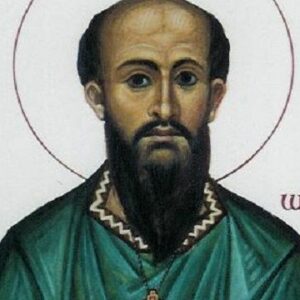The sixth-century Welsh bishop St. David is revered as Wales’ patron saint. Despite the fact that his exact date of birth is still up for debate, a fair lot of information about his life and period is accessible. The ‘Buchedd Dewi,’ a hagiography composed by Rhygyfarch in the late 11th century, contains a large portion of what is known about St. David today. Even if some of the allegations made in the book are disputed by contemporary historians, its author, Rhygyfarch, claimed that they were supported by records discovered in the cathedral archives. He is thought to have been born to an Irish noblewoman who lived in Dyfed. His mother was a devout woman who had chosen a religious lifestyle over life in the world. However, a monarch was captivated by her beauty and raped and pregnant her as a result. Tradition has it that St. David began working miracles while still within his mother’s womb. He was baptized as a child and was born in the midst of a fierce storm. He was raised to be a devout and holy guy and received priestly ordination. He established several monasteries and was active in missionary work. He was also well-known for leading an incredibly austere life that he inspired others to follow.
Early Childhood & Life
There are many unknowns regarding St. David’s conception and early years. Lady Non, the daughter of Lord Cynyr Ceinfarfog of Caer Goch, gave birth to him. Highly devout Non served as a nun at Ty Gwyn, which is close to Whitesands Bay. She was quite attractive, and Prince Sandde of Ceredigion pursued her after noticing her. She became pregnant as a result, giving birth to a son who would eventually become St. David.
When miracles began to occur while Non was expecting, many began to think that she was carrying a magnificent soul. Her newborn son was born in a sea of dazzling light as she was in the midst of a fierce storm. His birth year is unknown, however, it is thought that he was born sometime between 462 and 512. It is reported that an angel had told St. Patrick thirty years prior about the birth of St. David.
He was brought up by his loving mother, and St. Eilfyw, his maternal cousin, christened him when he was a young boy. Hen Vynyw, sometimes known as Henfynyw, is a monastery in Cardigan where he obtained his early education. He reportedly learned mathematics, astronomy, and music there, in addition to learning the alphabet and the psalms.
When he reached adulthood and became a priest, he went to the island of Wincdi-Lantquendi (perhaps Whitland) to learn the Holy Scripture from St. Paulinus of Wales. He performed a miracle there as well, curing Paulinus of his blindness and giving him his sight again with a simple touch.
During his almost ten years of study there, he established himself as an outstanding student. Around this period, he is also claimed to have studied under St. Illtud at Llanilltud Fawr (Llantwit Major).
A Later Years
St. David began his nationwide journey as an evangelist after completing his studies in religion. Although there is no evidence to support the precise number of monasteries he actually created, it is believed that he established roughly 12 of them. It is thought that Betws, Colfax, Llangyfelach, Ystrad Tywi, Glasgow, and Rafael were among the potential real foundations (Ystrad Tywi).
He also paid a formal visit to King Proprius of Ergyng, who was presumably King Peibio Clafrog, during his travels. The monarch was blind, but because to St. David’s amazing healing abilities, the king was able to regain his sight.
He established the monastery of Mynyw after returning from his travels with his pupils Aeddan, Teilo, and Ysfael (St. Davids). St. David and his monks adhered to a rigid Monastic Rule that called for extreme austerity in daily living.
The monks were obligated to forgo eating meat and drinking wine or beer, as well as pulling the plow without the aid of draught animals. Their main sources of nutrition were bread and water, and they had very little freedom of speech. They were required to pray continually at all times, and there was a drawn-out process involved in welcoming new monks to the monastery.
A neighboring Irish chieftain by the name of Bwya who resided at Castell Penlan was dissatisfied with the establishment of the monastery of Mynyw. To lure the monks away from their pious goal, Bwya’s wife dispatched her maid-servants. The Irish couple suffered as a result of their own malign intents, but the plot failed and bad things happened to them.
St. Teilo and SS. Padarn was St. David’s traveling companion as they made their way to Jerusalem. The patriarch of Jerusalem ordained the group as bishops. It is stated that a vision inspired him to travel to the holy city.
Saint’s Bigger Works
It is well known that St. David worked a number of miracles. He had the power to reverse blindness and even revive the dead. His greatest miracle, nonetheless, took place during the Synod of Brefi while he was preaching in the midst of a sizable throng. He was magically supported by a little hill that ascended, allowing his sermon to be heard by everyone in the area.
Personal Legacy & Life
According to some sources, St. David lived for more than 100 years. He is thought to have passed away on March 1st, a Tuesday. Since March 1 fell on a Tuesday that year, it is usually accepted that he passed away in 589.
As Christ received his soul, the monastery is supposed to have been “filled with angels.” At St. David’s Cathedral in St. David, Pembrokeshire, he was laid to rest. In the year 1120, Pope Callistus II canonized St. David.
Estimated Net Worth
A French luxury goods tycoon with a $50 billion fortune, François Pinault. In recent years, his net worth has increased astronomically.


